
Discover the story of Cutty Sark's magnificent gilding
By Claire Denham, Documentation Officer
Last month we saw the removal of Cutty Sark’s gilded gingerbread from around the stern of the ship. Essential restoration and re-gilding is required to ensure the longevity of the gilded scroll work. The pieces have been taken to gilding specialists, Campbell Smith & Co.’s workshop, where detailed analysis, restoration and gilding work is to be carried out.

The history of the gingerbread on the stern of the ship is long and varied. The first designed by Hercules Linton (designer of the ship) portrayed Robert Burns famous poem; Tam’ O Shanter. Depicted on her stern was a revealingly dressed witch; Nannie accompanied by devils playing bagpipes. This display of semi nudity and anti-religious connotation was seen as too distasteful for Victorian society and abandoned in its early stages.
Few historical images exist of the stern, but a photograph from our archive dated 1872, depicts the ship’s carpenter Henry Henderson proudly standing over the jury rudder he made, which saved the ship from ruin around the Cape of Good Hope. But of even more interest, below him in all its detail is what we believe to be the original gingerbread of the ship.
Under the Portuguese ensign as Ferreira (1895-1922) the gingerbread takes on a more muted appearance, with only Ferreira - Lisboa and a golden star emblazed on the stern.
A completely new design was created by the then Director of the Maritime Museum Sir Geoffrey Callender. During the ship’s residence at Greenhithe (1938-1954) the gingerbread bared no resemblance to the 1872 design, but with no historical documents to refer to and the need for a more fitting interpretation for Cutty Sark, the scroll work was a appropriate tribute to the ship at this time.
The 1872 image of the stern was the basis, along with some sketches by Hercules Linton for the design of the gingerbread during the 1950’s restoration, albeit with some conjecture involved in its design. The gingerbread was carved by Tommy Turner of ship repairers R.H Green & Silley Weir; this is the current design that sits on the ship today.

An extract from apprentice John Dodge, who worked on the gilding in 1950’s restoration, gives a fascinating insight into the gilding process.
‘We would take a leaf out of the gold leaf book, and we run take a sheet out with a comb – you’d run the comb through your hair to get a bit of static, hold it over the gold leaf and it used to leap onto the comb, and you could put it in position and pat it on and it was stuck on with egg white, which we used to buy from the grocer’s down the road, lots of eggs. And that was it, that was how it was done.’
Subsequent restorations in the late 70s, early 90s and 2006-2012 conservation project were essential for the gilding’s upkeep.
The current restoration was carefully planned with each individual piece (60 in total) removed, logged, photographed, wrapped and transported ready for consolidation works.
The bow elements of the gingerbread are next to be removed. During August you will be able to see the gilders at work on the ship, returning Cutty Sark’s gingerbread to her former glory, so why not pop down to the ship and take a look for yourself!